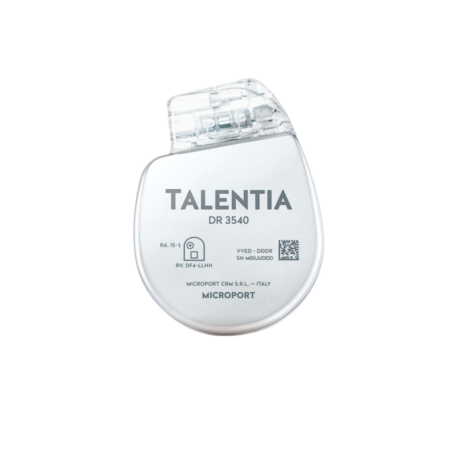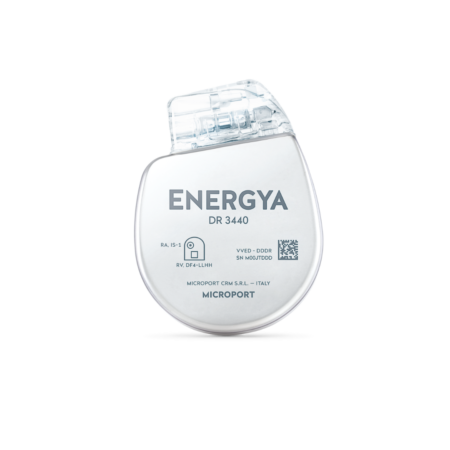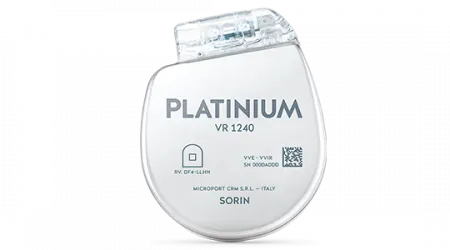Talentia™
Safeguarding your future
The new Talentia™ defibrillators represent Microport® CRM's latest development in the field of cardiac care.
In addition to the advanced protection against sudden cardiac death, improving patients' quality of life1,2,3 Talentia offers a Bluetooth Low Energy (BLE) connection for a seamless connectivity. Moreover, the world's greatest projected longevity4 protects your patients from complications associated with infections and replacements5.
AUTOMRI™ adaptive intelligence allows Talentia™ to automatically adapt to the MRI scanning environment, enabling essential therapies to provide a safe MRI pathway for your patients6.
Features
- BlueTooth Low Energy (BLE) connectivity – offers a high-quality connection for a seamless experience.
- Outstanding longevity4 – Protects patients from consequences of avoidable device replacement.5
- AUTOMRI™ – Provides the most appropriate therapy for as long as possible.
- PARAD+™ including the Long Cycle Search – Achieves the lowest rate of inappropriate shocks ever reported in the literature.2,3
- Lead Parameter Evaluation (LPE) – Enhances patient’s protection through earlier lead failure detection and alert.
- BTO™ – Brady Tachy Overlap. Supports patient exercise and detects slow ventricular tachycardia simultaneously.
- SafeR™ – Lowers the risk of atrial fibrillation and hospitalization associated with the RV overstimulation1.
- WARAD™ – Window of Atrial Rate Acceleration Detection. Accurately detects AF even in case of undersensing using a dynamic atrial window2.
- Remote Monitoring With Smartview™ Connect – Offers advanced patient monitoring and follow-up, providing timely alerts and detailed reports.
This product is not available for sale or distribution in the USA. For further information on product availability, please contact your local representative.

ENERGYA™
Designed with you in mind
The new Energya™ defibrillators represent Microport® CRM’s latest development in the field of cardiac care. The devices offer high-standard therapies and an effortless approach to patient management, saving valuable time for you and your patients. Moreover, with the world's greatest projected longevity4, Energya guarantees continuous, advanced patient care while BlueTooth Low Energya (BLE) connectivity, device dimensions, design, and preset programming make implantation and follow-up effortless.
AUTOMRI™ adaptive intelligence allows Energya™ to automatically adapt to the MRI scanning environment, ensuring that essential therapies are enabled and providing a seamless MRI pathway for your patients.6
Features
- BlueTooth Low Energy (BLE) connectivity – offers a high-quality connection for a seamless experience
- Outstanding longevity4 – Saves you from early replacements and associated complications.5
- AUTOMRI™ – Makes MRI pathway safe for your patients and easy for you.6
- PARAD+™ including the Long Cycle Search – Achieves the lowest rate of inappropriate shocks ever reported in the literature.2,3
- Lead Parameter Evaluation (LPE) – Enhances patient’s protection through earlier lead failure detection and alert.
- BTO™ – Brady Tachy Overlap. Avoids time-wasting parameter conflicts, making programming easier and faster
- SafeR™ – Eliminates deleterious right ventricular overstimulation.7
- Remote monitoring with SmartView™ Connect – Provides streamlined access to patient information, helping to prevent frequent or unnecessary hospital visits.
This product is not available for sale or distribution in the USA. For further information on product availability, pleasecontact your local representative.

Ulys™
Enhanced intelligence for optimal outcomes
Besides being the longest-lasting 1.5 and 3T full body MRI-conditional ICD1,2, Ulys™ features proven and physiological algorithms, reducing unnecessary and inappropriate therapies paving the way to improve clinical outcomes providing continuous and advanced patient care.3,4
AUTOMRI™ adaptive intelligence allows Ulys™ to automatically adapt to the MRI scanning environment, enabling essential therapies to provide a safe MRI pathway for your patients.2
Features
- Outstanding longevity1 – Protects your patients from early replacements and associated complications.5
- AUTOMRI™ – Makes MRI pathway safe for your patients and easy for you.2
- PARAD+™ including the Long Cycle Search – Achieves the lowest rate of inappropriate shocks ever reported in literature.3
- BTO™ – Brady Tachy Overlap. Supports patient exercise and detects slow ventricular tachycardia simultaneously.
- SafeR™ – Eliminates deleterious right ventricular overstimulation.4
- WARAD™ – Window of Atrial Rate Acceleration Detection. Accurately detects AF even in case of undersensing using a dynamic atrial window.6
- Remote monitoring with SmartView™ monitor – Offers advanced patient monitoring and follow-up, providing timely alerts and detailed reports.
This product is not available for sale or distribution in the USA. For further information on product availability, please contact your local representative.

Edis™
Adaptive technology for streamlined workflow and advanced patient care
Besides being the longest-lasting 1.5 and 3T full body MRI conditional ICD1,2, Edis™ guarantees continuous, advanced patient care while device dimensions, design and preset programming make implantation and follow-up effortless.
AUTOMRI™ adaptive intelligence allows Edis™ to automatically adapt to the MRI scanning environment, ensuring that essential therapies are enabled and providing a seamless MRI pathway for your patients.2
Features
- Outstanding longevity1 – Frees you from early replacements and associated complications.3
- AUTOMRI™ – Makes MRI pathway safe for your patients and easy for you.2
- PARAD+™ including the Long Cycle Search – Achieves the lowest rate of inappropriate shocks ever reported in literature.4
- BTO™ – Brady Tachy Overlap. Supports patient exercise and detects slow ventricular tachycardia simultaneously.
- SafeR™ – Eliminates deleterious right ventricular overstimulation.5
- Remote monitoring with SmartView™ monitor – Offers efficient access to patient data that keeps your patients out of hospital.
This product is not available for sale or distribution in the USA. For further information on product availability, please contact your local representative.

Platinium™
Enter a new era of longevity1
Thanks to its proven therapeutic functions2,3, Platinium™ is ready to protect your patients year after year and was designed to facilitate the implant experience and improve patient comfort.
Features
- World’s greatest projected longevity1 – Protects your patients from early replacements.
- PARAD+™ – World’s first dual-chamber arrhythmia discrimination algorithm. Best-in-class 99% overall specificity.2
- SafeR™ – Manages all types of AV block. More than 96% preserved intrinsic conduction.3




